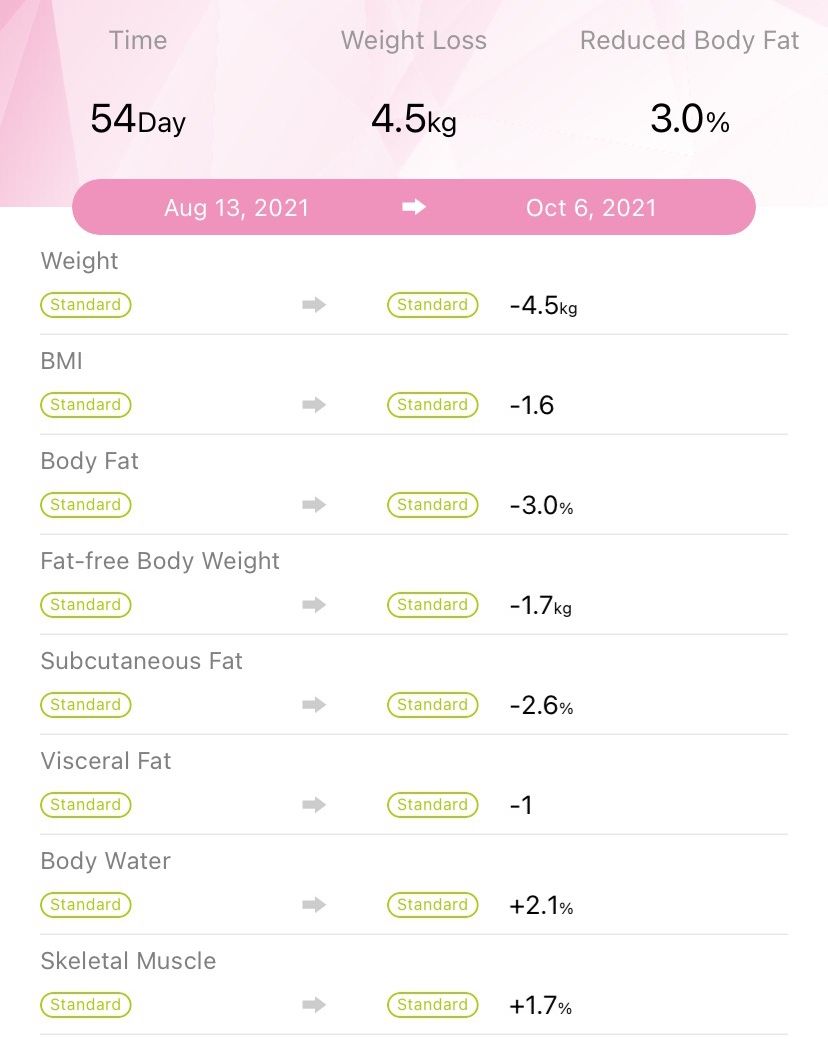7 Productivity Approaches Help You on Everything including Losing Weight
Available in English, Japanese/日本語 and Chinese/中文.

🇬🇧Subscribe if you would like to try to read in 3 languages!
🇯🇵日本語版はこちらをクリック、又は下にスクロールしてください!よかったら、サイトの「Subscription」フォームに登録して、無料のEメールサブスクリプションよろしくお願いいたします。
🇨🇳中文版请点击此处跳转,或参见本页下方。欢迎填写邮件订阅表格,免费订阅。

I've lost 4.5kg and reduced 3% body-fat percentage in 54 days in a healthy way
Introduction - In this post, I’m not going to talk about instructions on how to lose weight, but more on the mindset we need to stick to our plan. If you’d like to read about the detailed plan I followed, subscribe and stay tuned on my next post.
THIS may be a new angle to talk about weight-loss: 7 productivity approaches can even help you lose weight better. The following approaches or principles have helped me overcome procrastination and the three-minute passion, change my behavior pattern, and finally achieved my goal.
Actually, after this scientific weight-loss journey, I learnt a lot about self-improvement. What’s more fantastic is, I feel that these approaches can actually be applied to anything.
If you’re like me, having problems like procrastination and being lazy, please continue reading. 👇👇👇
1️⃣Define your goals and visualize it
The first step is to set goals: targeted weight, body fat percentage, muscle mass, etc., with numbers.
But more importantly, transform the above goals into something you can imagine, like the body shape of an ideal movie star, etc. My method was to find out what clothes I like and try my ideal size. I used to wear L size or even XL size. Skirts and trousers are basically L size, so I went to the store to try on size M clothes.
Now, the standard size of tops is M (brands like Zara wear S size), and bottoms have fully entered the age of S size, which is a huge surprise.
💡Some people advise to buy the ideal size before you start your diet... I consider it very unnecessary, because weight loss is a long-term process, and the clothes you bought last month may not remain your favorite ones now. In addition, no reason to buy a piece of clothing that you couldn’t wear immediately.
In short, the most important thing is to make the goal specific so that the brain can clearly understand the effect we want to achieve. I also mentioned it a bit at the beginning of the previous post. This is to make our adult brain realize the "necessity", otherwise it is difficult for us to continue to generate motivation and laziness will win.
2️⃣Transform your goals into habits
The following tips seem to be contradictory at first glance: after setting the goal, you need to transform the goal into habits, and then forget about the goal.
Let me explain.
The goal is actually a very abstract thing (even if we’ve complete our first bullet). When the brain understands the goal and says ,“Okay, let's start.” the first bullet is useful. However, after a period of time, I will soon forget the necessity and always be distracted by other things. After transforming the goal into specific habits and creating a plan, I wouldn’t need to think about how to achieve the goal in the actual execution. Whether I wanted to do a little more performance today or not, etc.
In this way, I prevented myself from wasting time to think about how to achieve an uncertain future (goal) and experiencing anxiety, which will only increase pressure.
So when I actually executed my plan, I just sticked to the habit-building plan. When you do it, the goal will take care of itself.
I listed up following habits to build -
- Carry out the calorie control plan I made and record the daily food calories
- Execute my daily water-drinking plan and use the app to record the amount of water
- Perform core training at least once a day
- 30 minutes of aerobic exercise 5 times a week
- Guarantee 8 hours of sleep
3️⃣Schedule your day
The next step is to develop a schedule for the implementation of the habit. It can be the key to ensuring the realization of bullet #2.
For me, this one was the biggest game-changer.
In a word, schedule everything into your daily calendar, and then stick to it.
Note that this schedule should not be too rough. For example, schedules like “learning in the AM” or “exercise in the PM” will hardly work. The calendar should be at least accurate at hour-level. Meanwhile, tasks should be broken down to minute-level (can be 15 minutes). Don’t forget to set aside time for rest, housework, and meals.
The advantage of this approach is to keep myself away from choices and avoid thinking about what I want to do next. Naturally, it is almost impossible to give up when you feel like you don’t know what to do, or you don’t seem to be motivated to do anything, which could happen.
Of course, I can adjust the schedule when something happens. And by adjusting the existing schedule sections 24 hours a day, I can more intuitively understand that I need to "allocate" time in a limited time, instead of “squeeze" time to do "extra" activities. It becomes less likely for me to skip tasks that need to be accomplished that day.
I also mentioned in my previous post that I’m using Google Calendar and created a personal Activity Calendar Group to do this.
4️⃣Track and review your progress
Next is to track our progress and review it every day. I use the Streaks app and Notion, and the Streak plays a major role here. In order to collect fitness data, I’m also utilizing calorie and diet plan apps, fitness tracking apps, etc. I’ll talk about this in detail in upcoming post.
The objectives are to see what I have accomplished, what I have achieved, and give myself positive feedback. I can also see what has not been done so that I can objectively understand the correlation between your "efforts" and "results."
Let me elaborate.
There are two benefits: first, sometimes we bury ourselves in daily activities, without realizing that we have made a lot of achievement. Use this positive feedback to motivate ourselves; second, if we sometimes skip many tasks, which will naturally affect the results. By reviewing our records, it will make it easier to understand the reasons for a not-so-good result, so that the brain will not feel “unfairness”, and all we need to do is continue to work hard to form a habit.
Another benefit is that through the review, I adjusted my diet plan and fitness plan several times during the period, including the intensity and timing, etc., in order to make myself better persevere. These are all achieved by looking back at the data and analyzing your own behavior patterns.
5️⃣Reward yourself
Note that the reward here does not necessarily mean "I want to buy XXX after losing a few kg" or "I want to eat XXX". I take it as any method that can improve one's motivation. Effective reward methods must vary from person to person.
In my case, there are three things that boost my morale the most during the entire process:
- Collecting all behavior data: This is related to personality. I like trying out various apps and new tools. Actually using apps through my own experience is a motivation in itself
- Strengthen the sense of accomplishment of completing the task: I enjoy the feeling of ticking a task to complete...so I have checked in Streaks, Notion, and Google Calendar. I can tick three times to complete a task, which triples the satisfaction.😂
- Definitely a food reward: every 30 days, allow myself to eat my favorite macadamia nuts (surprisingly super-high calories)
💡Did you notice that my food reward is not linked to the goal, but to the number of days. Remember our second bullet. When we are in execution, we should forget about the goal and focus on habit formation. The reason of this is that although there are occasional small slackness, if I have really implemented the habit for a period of time, psychologically, I will feel that I’ve worked hard. If I’m still some distance away from the milestone and not be able to get rewards, I’ll be disappointed. So I made this rule that as long as I followed my plan within a certain period of time, I could take rewards.
One more thing is, when the macadamia nuts were sealed and eaten again as a reward during the slimming period, the small nuts were more delicious than any time they had eaten in the past! Worth to try.
6️⃣Give yourself permission to have cheat-days
Self-discipline that does not fall for a long time sounds excellent. But I would think from the very beginning that no way for me to make it.
So I gave myself permission to have a weekend every two weeks for a little cheating. I can eat my favorite food in the restaurant, just paying attention to avoiding high-calorie and low-nutrient food.
Technically I was not on a diet on cheat-days, but calories still need to be calculated to understand how much I was over my budget.
On the next day, according to my physical condition, I would take a light fasting or add extra exercise to make up for it. (But don’t do exercise vigorously during fasting. I have tried it. It’s very painful and I would really like to eat even more.)
Having cheat-days can avoid feeling guilty when I didn’t follow the plan and make it easier to persist.
If you are interested, you can search for scientific fasting the next day after overeating.
7️⃣5-min Rule
Okay, now we have the previous 6 items as a basis, which looks perfect. But the reality is always different. Maybe you are the same as me in the past. You may respond to above words that, "These are stories about others. It won’t work in the real world.”
That’s why I’ve got bullet #7.
When I felt lower motivation, I would tell myself "just do it for 5 minutes. If I feel bored or have no energy after 5 minutes, I can just end it.”
It’ll then be tremendously easier to start. In most cases, as long as I can start a task for 5 minutes, usually I will could somehow make it. After all, the hardest part is to start.
💡To practice this rule during weight loss, I’d say that exercising at home or nearby, rather than a gym, is more suitable for lazy people.
It's almost impossible for you to tell to yourself that "Go to the gym today, but I can go home in 5 minutes”, right?
In contrast, if you exercise at home, or go for a walk or run, it’s completely your call when you are tired. This will make it easier for you to start.
Looking back on the failed exercise plans in the past, I concluded that choosing a gym or a personal trainer from the beginning actually raised the bar of exercise. Starting from going regularly to going occasionally, I would always find reasons to quit in the end.
More important to keep exercising than to do high-intensity exercises. Start at home, start immediately. Gym is better for the stage after the exercise habit has been formed. (Personal opinion, people who have exercise habits are certainly not included in this list.)
This article is fully based on personal experiences. Note that you should always consult a doctor or professional before starting any diet or exercise plan.
プロダクティビティ7か条で人生を変える。ダイエットが奇跡的に成功する
〜54日間で4.5kg減、体脂肪率3%ダウン〜
前書き : 今回は具体的なダイエットや運動のプランではなく、マインドセットをトピックとして話します。実際に実施したプログラムの詳細についてご興味がありましたら、サブスクリプションしていただき、これからのブログ更新を楽しみにしてください。
少し新しい角度から減量について話しているかもしれない。
これらの7つプロダクティビティのアプローチは減量にも適用できる。
私が実践した以下のアプローチ又は方針は、先延ばしの癖、三日坊主を克服し、行動パターンを少しずつ変え、最終的に目標を達成することに繋がった。
今回の減量に通じて、いろんな自己改善の体験ができた。良いことに、これらのアプローチは今後何にでも適用できると思う。
私と同じ、先延ばし、やる気ない、三日坊主等の課題があると思われる方は、読み続けてください。 👇👇👇
1️⃣目標を定義して言葉だけでなくイメージする
言うまでもなく、まずは体重、体脂肪率、筋肉量などの目標を数字で定義すること。
しかし、もっと重要なことは、上記の数字を想像できるイメージすること。たとえば、理想的なスターの体型。
私の方法は、好きな服を見つけて、理想的なサイズを試着していた。ダイエットの前、LサイズやXLサイズ、スカートやズボンは基本的にLサイズだったので、敢えてMサイズの服を試着してみた。
今、トップスの標準サイズはM(ザラなどのブランドはSサイズを着用)で、ボトムスはSサイズの時代に突入した。
💡目指すサイズの服を購入してしまうと言う人もいるけど...減量は比較的長期的なプロセスであり、先月購入した服は来月ではもう着る気がなくなっているかもしれないし、無駄な出費だと思う。買ってすぐ使えない服は買う意味なし。
要は、達成したい効果を脳が明確に理解できるように、目標を具体化すること。前回の記事の冒頭でも少し触れたが、大人の脳に「必要性」を認識させるため。そうしないと、モチベーションを出し続けることが難しく、怠惰になりやすい。
2️⃣目標を習慣にブレイクダウン
次のヒントは一見矛盾しているように見えるかもしれない。目標を設定した後、必ず習慣にブレイクダウンし、そして目標自体を一旦忘れること。
何故ならば、目標というものは、実は非常に抽象的(1点目で具体化したとしても)。脳が理解して「さあ、始めましょう」と言うと、最初のものは役に立つ。しかし、時間が立つと、行動の最初に理解した必要性は忘れがちで、他のもっと楽しそうなことに目を向けてしまう。
目標を習慣にトランスフォームして実施計画を立てた後は、実行の時目標自体を考える必要がなくなる。不確実な未来を手に入れる方法(目標)を考える無駄の時間を作らない。要らないストレスを増やすだけだから。
繰り返すと、目標そのものではなく、定義した習慣形成計画にフォーカスする。それの積み重ねで、目標は自然と達成される。
私の例に戻ると、次のように習慣化目標を定義した。
1.ダイエット計画を実行し、毎日のカロリー摂取を記録
2.毎日の水分摂取を実行し、アプリを使用して摂取量を記録
3.エクササイズのメニューの中に、体幹トレーニングだけ1日1回の実行をコミットメント
4.週5回の30分の有酸素運動
5.8時間の睡眠を確保
3️⃣一日のスケジュールを必ず組む
習慣の実施のために最も重要なのはスケジュールを作成すること。
私にとって、このステップは第2条を確実に実現するための鍵であり、最大のゲームチェンジャーだと言っても過言ではない。
カレンダー上、やるべきことすべて時間単位で入れること。
留意すべきなのは、スケジュールは細かく定義するように。「午前中運動」「午後勉強」みたいに入れてしまうことないか?実はそのようなスケジュールはほとんど効果なし。
少なくとも1時間単位で刻むべき。できれば、それ以上に細かくても良い。(15分単位とか)。ただし、あくまでも実施可能な範囲で。休憩、家事、食事の時間を確保するように。
そうすると、次に何をしたいのかを選択する権利をなくし、考え考えないようにするためだ。自然に何をすべきかわからないからあきらめることや、やる気ないからだんだんスケジュールから乖離する可能性が低くなる。
もちろん、何かのイレギュラーがあったら、スケジュールを調整する。けれども、既存のスケジュールにあるセクションを24時間の中で調整することで、時間を「作る」のではなく、限られた時間に「割り当てる」アクションになる。 これで、タスクをスキップする可能性を低くくなる。
前の文章で言及されたが、私の場合、無料のGoogleカレンダーを使用し、個人のアクティビティカレンダーグループを作成して管理していた。
4️⃣進捗状況の追跡と振り返り
次は、進捗状況を追跡し、毎日簡単にレビューして振り返りすること。
私はStreaksアプリとNotionを使用している。Streaksの機能が一番役に立つと感じた。
なお、フィットネスデータを収集するために、カロリーの記録とダイエットプランのアプリ、フィットネス追跡アプリなども組み合わせて使用する。また、別のブログ記事をアップして詳しく説明していきたいと思う。
進捗状況を追跡することで、何を達成したか、どのような成果を出したかを確認し、正しく自分にフィードバックすること。同時に、何ができていないかを確認し、結果を照らし合わせすることで、「努力」と「成果」の関係を客観的に理解することができる。
言い換えると、2つのメリットがある。一つ、エクスキューションしながら、本当はたくさんの努力を積み重ねてきたことに気付かない可能性があるので、ポジティブなフィードバックを自分に与えること。一つ、たまにスキップすることもあると思うが、結果に影響することもあるでしょう。その時、記録を確認することで、結果が悪い理由を理解しやすくなり、脳が「アンフェア」なを感じず、ただただ、引き続きがんばるんだと思わせること。
また、振り返りすることで、よりやりやすいためにプランの粒度、インテンシティ、タイミングなどを含めて、ダイエットとフィットネス計画を数回調整することもできた。これらはすべて、データを振り返り、自分の行動パターンを分析することが前提となっている。
5️⃣リワードを作る
ここでいうリワードは、必ずしも「数kg減った後にXXXを買いたい」や「XXXを食べたい」ではない。モチベーションを向上させる方法なら何でも有り。効果的なリワードはきっと人によって異なる。
私の場合、モチベーションを保つリワードは3つ。
- すべての行動データを取ること:好みによるものだが、さまざまなアプリや新しいツールを試してみるのが好きなので、実際に自分の経験を通じてアプリを使用すること自体はすでにモチベーションになる。
- タスクを完了する達成感:タスクをチェックする感覚は楽しくて...Steaks、Notion、およびGoogleカレンダーに全部チェックリストを作成した。タスクを完了する度、全部で3回チェックすることができる。3倍の満足度になる。😂
- 食べ物のリワードは王道:30日ごとに、お気に入りのナッツマカダミアナッツを食べるようにしていた(チェックしてみてください。驚異的な超高カロリー)
💡リワードはマイルストーンの達成ではなく、持続日数とリンクしていることに気づいたか?2点目のアプローチに説明したが、実行の時、目標は一旦忘れる。
何故ならば、たまに少しサボったりしても、一定の期間でプランどおりに行動していたら、頑張った感がである。それなのに、マイルストーンに何等かの原因で到達していないから、リワードを得られない場合モチベーションを低下させる。よって、所定の期間で実施したら、もうリワードされるというルールを作った。持続する重要なポイントだと考える。
余談になるが、ダイエットでマカダミアナッツを封印し、ご褒美としてに食べる時、これまで感じたことのない美味しさだった!それだけでもこのような方法をトライする価値有り。
6️⃣チートデイを自分に与えること
長い間ずっとストイックというのはとてもすばらしい。しかし、私みたいなタイプは最初からそれができないことをわかっていた。
そのため、2週間ごとに週末を少し贅沢し、レストランで好きなものを食べても良いというチートデイを作った。当然、高カロリーで低栄養のものは避ける。
厳密的に言うと、チートデーはダイエットしない。ただし、カロリーはどれだけ超えたかを明確に把握するため、カロリーを正しく記録しなければならない。そして 翌日は、体調に応じて、軽く断食したり、追加の運動をしたりしてチャッチアップする。(ちなみに、断食中は激しく運動しないように。私は試したが、非常に苦痛であり、補うためにもっと食欲が湧いてきてしまう。)
チートデイを織り込むことで、計画に従わなかったときの罪悪感を軽減する。持続しやすくなる。
ご興味があれば、食べ過ぎた翌日の科学的断食などを検索してみてください。
7️⃣5分間ルール
さて、ここまで6つのアプローチでベースができた。完璧に見える。しかし、現実は常に残酷だ。皆さんは昔の私と同じであれば、ここまで読んだら、「所詮他の人の話だ、応用できない」と言うでしょう。
そのために、世界を変える7点目の出番。
やる気がないときは、「5分間やるだけ。5分後でも退屈したり、やる気が湧いてこないなら終わさせて良い」と自分に言い聞かせる。それで少なくとも始めやすくなる。実際、ほとんどの場合、5分間スタートできるなら、そこそこできる確率が高くなる。なんせ、世の中最も難しいところはは始めることだから。
💡また余談。運動の形に関して、個人的にジムより自宅または自宅の近くで行うことはあまりストイックでない人に適していると思る。 「今日はジムに行くけど、イヤなら5分で帰る」と自分に言い聞かせても無理がある。一方、自宅で運動したり、散歩やランニングする場合、完全に自分でコントロールできるので、疲れたときに立ち止まることができます。つまり、スタートするハードルが低くなる。
過去に失敗した運動計画を振り返ると、最初からジムやパーソナルトレーナーを選んでしまったから、運動のハードルを高くしてしまったと結論付けた。だんだん、定期的に行くことから時々行く、そして何等かの理由を見つけてやめてしまう。
高強度の運動をするよりも続けることが大切。家で始めたり、すぐに始めたりしましょう。ジムは、運動習慣が確立された後のステージに適する。 (個人的な見解です。)
ご留意:この文章はあくまでも個人的な経験によるものです。実際にダイエットや運動を実施する前にご自身の状況により医者や専門家のご意見をご確認ください。
7条效率提升原则改变生活,奇迹减重
——54天内瘦4.5kg、体脂下降3%
写在前面 - 本文并不探讨具体的减重计划。如果对实际执行的详细计划感兴趣,欢迎订阅此博客并关注接下来的推送。
可能是一个全新的角度讲瘦身:这7条效率提升的原则,甚至可以帮你更好的减重。我导入的下面几个原则或者说作战方针,帮助自己战胜了拖延症、三分钟热度,在可能的范围内一点一滴的改变自己的行为模式,最终达到目标。——经过这次的科学瘦身,体会到了很多自我提升的心得。妙的是,这些原则可以应用到任何事情。
如果你觉得和我一样,有拖延症、懒癌晚期这样的问题,欢迎继续阅读。👇👇👇
1️⃣Define your goals and visualize it / 定义目标不仅限于文字,还应将其具像化
第一步当然是定下目标:体重、体脂率、肌肉量等等,数字化。
但更重要的是,将上面的数字目标转换成自己能够想象的形象。比如说理想的明星的体型。我的方法是,找出自己喜欢的衣服,去试自己理想的尺码。比如上衣,发胖以后我原本一直穿L号甚至XL号,裙装和裤装基本L号,所以我就特意去店铺试穿M号的衣服。
现在,上衣的标准尺寸是M(Zara这类品牌穿S号),而下装已经全面进入S尺码时代,这是个巨大惊喜。
💡有的人说把理想的尺码买下来……我认为这种花费非常没必要,因为减重是一个相对长期的过程,况且上个月你买的衣服,下个月说不定你就不喜欢了,何必买一件自己当时穿不上的衣服呢。
总之最重要的是将目标具体化,让大脑能够明确理解我们要达到的效果。上一篇推送开头我也稍微提到过,这是为了使我们的成年人大脑体会到“必要性”,否则我们很难持续产生动力,非常容易懒惰。
2️⃣Transform your goals into habits / 将目标分解为习惯
接下来的tips乍看有一些矛盾的:定好目标之后,需要将目标分解成习惯,然后就忘记目标。
接下来我会解释。
目标其实是个很抽象的东西(就算在第一条我们具像化了)。大脑在理解说“好,我们开始干吧”的时候,第一条有用,但是,等到时间长了,我很快就会忘记一开始行动时理解的必要性,永远会被其他更有吸引力的东西分散注意力。而把目标分解成具体的习惯养成计划之后,实际执行中不再去想怎么达成目标,今天要不要多做一点成绩之类的问题,阻止自己为如何实现不确定的未来(目标)而浪费精力焦虑。因为那只会增加无谓的压力。
所以我真正在执行的时候,面向的不是目标本身,而是我分解的习惯建立计划。当习惯有了一定积累之后,目标自然会达成。
比如我分解成了以下几个习惯:
- 执行我制定的热量控制计划,记录每天的食物卡路里
- 执行我每天的饮水计划,用app记录饮水量
- 每天至少进行一次核心训练
- 每周5次30分钟有氧运动
- 保证8小时睡眠
3️⃣Schedule your day / 建立具体的日程表,安排我们的每一天
下一步关键的事情是:制定执行习惯的日程。
这一步可以说是保证第二条实现的关键。
在我这次的科学减重期间,这一条是最大的game-changer。
一句话说就是:将要做的事情安排到日程表里,然后将自己交付给日历,到点执行。
要注意的是,这个日程表不应该过于粗略,比如上午学习下午运动,那几乎不会有效果。日历应该至少精确到小时。同时将每个要做的事情也按照小时、分钟(可以是15分钟)单位分解开,注意要预留出休息、家务、吃饭时间。
这样做的好处是,剥夺自己选择的权利,避免去想下一步我想做什么。于是自然的,几乎不会出现不知道做哪件事,又好像哪一件都不是很有动力去做,最后放弃的情况。
当然,有突发情况发生的时候我会对日程做调整,但是,通过在一天24小时当中调整已有的日程板块,我能更直观的理解自己需要在有限时间当中“分配”时间,而不是“挤”时间做“多出来的”活动。这本身也能让我较不可能skip当天需要达成的任务。
同样在上一篇推送中稍微提到:我使用免费的Google Calendar,新建一个个人的Activity Calendar Group来做这个动作。
4️⃣Track and review your progress / 追踪和回顾
接下来的一个重要原则是追踪我们的进程并每天简单总结。我用Streaks app和Notion来实现,其中Streaks的打卡在这里起到主要作用。为了收集健身数据,也配合使用卡路里和饮食计划app,健身追踪app等。会在另外的blog文章中详述。
这里的目的是通过追踪进程,我可以看到自己完成了哪些事情,获得了哪些成就,给自己肯定的反馈。同时,也能看到哪些事情没有做到,然后比对结果,客观理解自己的“努力”和“结果”之间的关系。
——白话一点说就是,有两个好处:第一,有时候我们埋头执行习惯,会意识不到自己做了很多努力,这时候应该用正面反馈激励自己;第二,如果我们有时候skip掉的task比较多,那自然会影响结果,这时候回顾我们的记录,就可以更容易理解成果不佳的原因,让大脑不会产生不公平感,而知道要做的只是继续努力养成习惯。
另一个好处是通过回顾,我调整过好几次自己的饮食计划和健身计划,包括强度和时间安排等等,以便让自己更好的坚持。这些都是需要通过回头查看数据,分析自己的行为模式来实现的。
5️⃣Reward yourself / 一定要有奖励机制
注意这里的reward不局限于“瘦了几kg以后我要买XXX”或者“我要吃XXX”,我将它扩大解释为一切能够提高自己动力的方法。有效的奖赏方式一定是因人而异的。
拿我来说,整个瘦身过程中最能提高我士气的有三件事:
• 所有行为数据化:这是和性格有关的,我很喜欢试用各种app和新工具,通过自己的经验实际使用apps本身就是一种动力
• 强化完成任务的成就感:我非常enjoy给一个任务打勾完成的感觉……所以我在Streaks、Notion、Google Calendar全都做了打卡,完成一个任务可以打勾三次,三倍满足感😂
• 果然还是食物奖赏:每坚持30天,允许自己吃最喜欢的坚果——夏威夷果(大家可以查一查,瞠目结舌的超高热量)
💡是否注意到我的食物奖赏不是链接到阶段性目标,而是链接到坚持天数上。记不记得第二条说了,到执行阶段,我就会忘记目标,把精力集中在习惯养成上。理由如下:虽然偶尔有一些小小的松懈,但是如果我已经执行了一定时间,心理上会产生自己努力了的感受,这时候如果因为各种原因没能达成阶段性目标而得不到奖励,会影响积极性。所以我规定,只要在一定期间保证执行了自己的计划,就有资格得到奖励。这成为我能有效坚持的一大关键因素。
而且,在瘦身期间封印夏威夷果之后,作为奖励再吃的时候,小小的坚果比过去吃的任何时候都美味!有点饥饿营销的意思。值得试一试。
6️⃣Give yourself permission to have cheat-days / 允许自己放假
长期一天不落的自律当然是非常优秀的。但是我从一开始就知道自己做不到。
所以我允许自己每两周可以有一个周末稍微放纵一下,可以去餐厅吃喜欢的食物——当然一定程度上注意避免高卡路里低营养的食物。
Cheat-day当天,不需要严格控制,但是依然需要计算卡路里,这样可以明确把握自己超了多少预算。第二天根据自己的身体状况,可以进行轻度的断食或者追加运动量补回来。(不过不要在断食的时候进行激烈运动,我试过,非常痛苦,会很想暴食。)
通过给自己准备救济计划,避免在不遵守计划时产生罪恶感。心理上更容易坚持。
有兴趣的话大家可以搜一下吃过量之后如何科学断食等等。
7️⃣5-min Rule / 5分钟规则
好,现在我们有了前面的6条作为基础,看起来挺完美。但现实总会是很残酷的。也许你和过去的我一样,就算看了前面也会说“这些都是别人家的故事,纸上谈兵,肯定坚持不了”。第7条就是改变世界的杀手锏。
比如当我觉得没什么动力运动时,我会想“就干5分钟,如果做了5分钟觉得无聊或者没力气就结束”,更容易开始。而大部分情况是,只要你能让自己开始一个任务5分钟,大概率你能完成个八九不离十。因为任何事情,最难的其实是开始。
💡和本条相关的题外话:个人认为在家或者在家附近运动,比起健身房更适合懒人。你几乎不可能对自己说“今天去健身房,但是我可以5分钟就回家”对吧。与此相对,如果在家锻炼,或者出门散步、跑步,你可以完全独立自主,累了就停。这样可以让更容易开始。
回顾过去失败的运动计划,我总结很大程度上一开始就选择健身房或者私人教练,其实是无形中提高了运动的门槛,从定期去变成偶尔去,最后总可以找到这样那样的理由,导致不了了之。
比起零零散散的做高强度运动,坚持持续锻炼更重要。在家开始、立刻开始。健身房更适合已建立运动习惯之后的阶段。(个人见解,有运动习惯的人士当然不在此列。)
声明:本文仅为个人经验。在开始实际减重或者运动计划,请根据个人情况咨询医师或专业人士。




